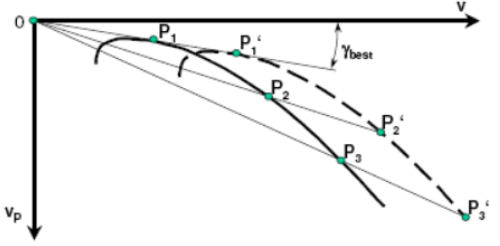In the loading/polar dialog, the right polar for the aircraft type is selected, masses can be adjusted and the polar that is set can be tuned manually.
Glider Type #
[User Polar] [Antares 20E] [ASK 21] :
With this the polar for the corresponding type of aircraft can be set.
There is also a polar [User-Polar], e.g. for an aircraft type that is not contained in the library. the
[User Polar] is selected by default and corresponds to the values for an LS4a. There is an extensive and constantly growing library.
The current list of supported polars in the library can be found here: https://github.com/iltis42/XCVario/blob/master/main/Polars.cpp
Note: When updating from older software versions before mid 2021, the set polar must be checked after the update, the adoption of the setting may not be correct. With an upgrade from newer software versions from June 6, 2021, the problem is solved and the check is no longer necessary.
Polar Points #

[Wingload] 34.4 kg/m2 [Speed 1] 80 km/h [Sink 1] – 0.66 m/s [Speed 2] 125 km/h [Sink 2] – 0.97 m/s [Speed 3] 175 km/h [Sink 3] – 2.24 m/s
Under PolarAdjust, the reference wing loading and the sink values for the individual speeds can be modified. The reference wing loading is the value at which the polar was flown and is usually given with the polar. If the current wing loading is higher even without ballast, then this must be set under “Fixed Ballast” see below. Normally, the reference wing loading should not be changed and must agree with the information from the polar. For this wing loading, the corresponding sink values [Sink 1,2,3] are to be set at three points according to the polars from the flight manual at the corresponding speeds [Speed 1,2,3]. The respective decrease is recorded as a negative value. Ideally, you should take the first speed around the lowest sink rate, then an average speed and a reasonable highest speed which is relevant for the cruise mode.
Modifications to the selected polars are reset by selecting a different aircraft type. Normally, only the aircraft type has to be set, an adjustment of the above parameters is not normally necessary, further aircraft types are promptly integrated into the library by XCVario on request, and are immediately available after a SW update.
Max Ballast #
160.00 liters
The maximum possible water ballast can be modified here. This parameter is usually given by the aircraft type and comes from the polar library according to the manufacturer’s information, but can vary due to modifications such as adding winglets or installing other water bags, and can be modified here accordingly.
Wing Area #
10.5 m²
Here the wing area can be modified. These parameters are actually given by the aircraft type, but can vary due to modifications such as attachable wings or winglets, and can be modified here accordingly.
Empty Weight #
265 kg
With “Empty Weight” or empty mass, the empty weight or empty mass can be set more precisely. Gliders tend to get heavier over time, not only because of the installation of instruments, the addition of winglets or repainting, but also the CFK or GFK itself draws water over time and becomes heavier as a result. In order to take this into account, the empty weight can be set to a higher value than that which was used as the basis for determining the gliding polars in the comparison flight. As a default, when selecting the polar, the empty mass is entered from the flight weight minus the pilot’s weight. A higher empty mass thus improves gliding at higher speeds and, like normal water ballast, contributes to increasing the wing loading.




